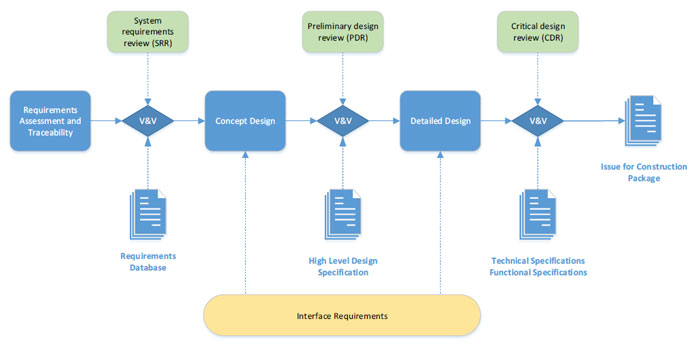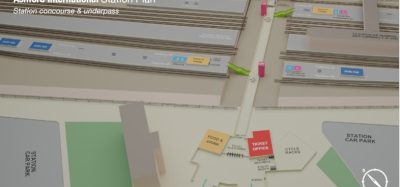Interface management in railway projects: A systems approach
Posted: 20 April 2018 | Pedro Neves - Sweco Norge | 4 comments
With railway projects experiencing increased technological complexity and performance expectations, Pedro Neves, Transportation and Infrastructure Specialist at Sweco Norge, explores how the concept of interface management can support railway project teams to mitigate interface-related risks by controlling interface issues from an early stage of a project’s life-cycle.


Project interfaces are defined as: “The boundary between two parties or systems involved in a project”. Interface management is the process used to ensure that all relevant specifics about these touchpoints (or interfaces) are addressed and shared in a consistent, timely and efficient manner between all contractors, design teams and any other relevant stakeholders involved in the project.
Interface management supports project teams to mitigate interface-related risks by controlling interface issues from an early stage of the project life-cycle, as well as by building collaboration and lines of communication between project participants. Documenting interfaces and providing solid communication allows different contracting parties to be aligned and helps establish clear lines of responsibility and scope whilst bridging the space between them.
The outcome is improved project performance and a reduction in the probability of costly mistakes and reworks. Successful interface management can lead to avoidance of time-consuming disputes, guaranteeing complete understanding of, and agreement with, all decisions regarding project interface issues.
Systems engineering for improved interface management
To embed in interface management process as a system’s approach, it is necessary to walk towards an established and solid framework that uses a multidisciplinary method which can ensure a successful outcome of the considered systems, referred to as systems engineering. Systems engineering is the cement between all the bricks that compose a project, namely project management and engineering deliverables.
Nowadays railway projects experience increasing technological complexity and performance expectations. We can divide railway systems into three large groups: Rolling stock, fixed infrastructure and operations.
Rolling stock
Vehicles that, for operations or maintenance purposes, use the railway infrastructure.
Fixed infrastructure
A set of physical systems required to establish a railway in a safe manner:
- Track – the structure consisting of rails, fasteners, sleepers and ballast (or slab track), that provides the required surface for rail/tram wheels to roll upon
- Signalling and automatic vehicle location – ensures safe separation between rolling stock and allows an improved performance towards the defined headway
- Traction power – substations and transmission (i.e. catenary and third rail) provides the necessary electrical power
- Supervisory control and data acquisition – provides real-time data on key elements of the infrastructure.
Operations
Although they could easily be included under infrastructure, the following systems are provided to support operation:
- Operation command centre – a central location with the relevant workstations, to supervise, operate and provide command, coordination and decision-making for day-to-day operation or in the case of an incident
- Passenger information and public address – provides visual and audio information on headway, departures and other operational details
- Radio communications – to allow communications between command centre operators and rolling stock drivers or maintenance teams
- Closed-Circuit Television (CCTV) – provides visual monitoring of railway premises and public areas in the surroundings of the railway
- Automatic revenue collection – provides secure revenue collection and associated records.
From the systems engineering processes, interface management will focus mainly on the following:
- System requirements – where the relevant stakeholders’ expectations are transformed into verifiable interface requirements
- Verification and validation – to assess if interface requirements are being addressed properly and according to expectations.
Interface classification
The approach followed to classify each interface is based on a contractual relationship between the parties involved in the interface itself:
- Internal interfaces are those between or within contracts under the main engineer scope. These can be divided respectively into inter-contract or intra-contract interfaces
- External interfaces are those between contracts under the main engineer responsibility and third parties, i.e. other contracts and (not restricted to) local authorities.


Other contracts are defined in this process as the contractor being responsible for all the activities during the project life-cycle, from design, procurement and construction/installation to commissioning and the handover of the project to the client. Nevertheless, assuring proper integration in the overall design often falls under the responsibility of the main engineer.
A local authority, under an interface management process, defines an administrative unit of government or regulatory organisation/company involved in the project or whose interests may be affected by the execution of the project.
Especially for design-build or turn-key contracts, internal interfaces are to be addressed more in a standpoint of systems integration, i.e. systems are to be delivered as a whole. This approach allows the interface management process to focus on variables that are not solely controlled by the contractor.
Interface requirements
Requirements management is the process of capturing, assessing and assuring that all relevant stakeholders’ needs are taken into consideration at an early stage of the project. Since interface requirements may be provided by stakeholders that comply with a schedule with different milestones, it is of utmost importance to establish a common understanding of when those requirements will be taken into consideration.


Control tools
Processes and tools described within this section are to be used under the interface management process to assure proper control and tracking of all interface issues.
Interface register report
A key tool for managing interfaces is a consistent interface register report. This provides access to accurate up-to-date information and visibility on interface status and activities.
Availability of interface information ensures that all parties involved can review items more thoroughly and make decisions quickly with more accuracy, prioritising critical issues.
Interface meetings and workshops
Agreement between the different parties involved in an external interface is essential. Therefore, meetings must be held periodically and shall be attended by representatives from the client and stakeholders responsible for the relevant interfaces. The purpose of meetings and workshops is to maintain the integrity of the interfaces by ensuring that:
- Parties on both sides are working towards the same interface baseline
- All system changes are evaluated for related impact regarding interface(s)
- No changes are accepted without formal approval on both sides of the interface.
Before the submission of a documentation package, workshops must be held to create a common baseline and identify conflicts/clashes and grey areas.
Request for information (RFI)
During design and construction phases, all agreements, drawings and specifications are at risk of not adequately addressing every single matter or having different interpretations. There may be gaps, conflicts or subtle ambiguities.
The goal of the request for information (RFI) is to act as a partnering tool in the form of formal query asked by one party to another.
It is important to record the dates that RFIs are dispatched, the dates by which responses are required and the dates that responses are received, to provide evidence if a dispute arises.
The requirement to respond to an RFI is created by the obligation to provide further information, as this is necessary to enable the other party to complete the contract on time. Requests should however give sufficient notice for the respondent to be able to resource and prepare a reply by the date that the information is required. The parties are then entitled to rely on the information provided as correct.
Interface control documents (ICDs)
Different stakeholders are responsible for creating relevant interface control documents to compile all interface requirements (both inputs and outputs) towards other contracts. This is to assure proper compatibility and integration with the overall system.
Each turn-key contractor owns the responsibility of refer on their design documentation (ICDs and referenced drawings or documents), which features and characteristics that, if altered, would affect interfaces controlled by the ICDs. Any design change affecting an ICD controlled feature or characteristic must be clearly identified and promptly communicated to all relevant parties, i.e. here being the client and the main engineer.
Closing the interfaces
After a sometimes-challenging process for interface agreement between all relevant stakeholders, it is necessary to assess impact in the overall project. For this, the project management team must also have a solid and structured change management process. It is not unusual that the agreements influence scope, schedule and cost, that must be dealt with by the referred process.
Stay Connected with Global Railway Review — Subscribe for Free!
Get exclusive access to the latest rail industry insights from Global Railway Review — all tailored to your interests.
✅ Expert-Led Webinars – Gain insights from global industry leaders
✅ Weekly News & Reports – Rail project updates, thought leadership, and exclusive interviews
✅ Partner Innovations – Discover cutting-edge rail technologies
✅ Print/Digital Magazine – Enjoy two in-depth issues per year, packed with expert content
Choose the updates that matter most to you. Sign up now to stay informed, inspired, and connected — all for free!
Thank you for being part of our community. Let’s keep shaping the future of rail together!
Related topics
Digitalisation, Security & Crime Management, Technology & Software








Very interesting and educational, everyone engaged in the mega project must learned and understood the processes pf the interface management. Thank for sharing this papers to us.
Very helpful information. Described end to end Interface management and covered all the areas of Interface.
Pedro,
Great article on interface management. Thanks for sharing it.
I`m proud to have worked in the same project as Pedro since 2012, Bybanen i Bergen Norway, here he describes in a good way how to handle Interfaces